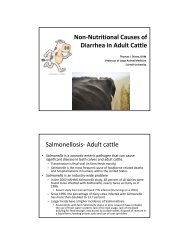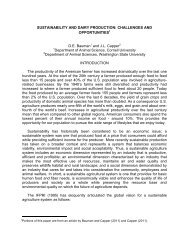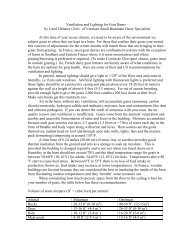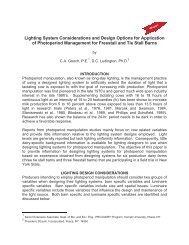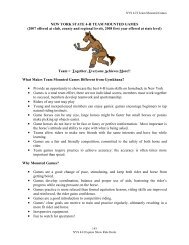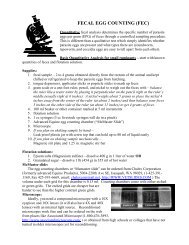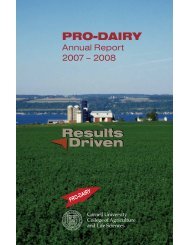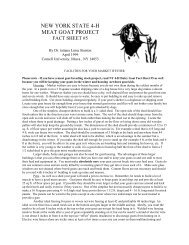NEW YORK STATE 4-H DAIRY GOAT PROJECT - Cornell University
NEW YORK STATE 4-H DAIRY GOAT PROJECT - Cornell University
NEW YORK STATE 4-H DAIRY GOAT PROJECT - Cornell University
Create successful ePaper yourself
Turn your PDF publications into a flip-book with our unique Google optimized e-Paper software.
<strong>NEW</strong> <strong>YORK</strong> <strong>STATE</strong> 4-H<br />
<strong>DAIRY</strong> <strong>GOAT</strong> <strong>PROJECT</strong><br />
FACT SHEET #17<br />
By Dr. E. A. B. Oltenacu<br />
Revised April 1999 by Dr. tatiana Stanton<br />
<strong>Cornell</strong> <strong>University</strong>, Ithaca , NY 14853<br />
REPRODUCTIVE PROBLEMS OF THE DOE<br />
cover:<br />
A variety of health problems may be associated with reproduction in the doe. This fact sheet will<br />
1) ketosis<br />
2) retained placenta<br />
3) milk fever<br />
4) genetic infertility<br />
5) metritis<br />
Ketosis (acetonemia, pregnancy toxemia). This is a metabolic disease, which means that it is a disturbance<br />
in the normal body processes, not something "catching". It is most likely to occur just before kidding or<br />
within the two to four weeks after. Does that are extremely overweight or underweight, carrying several<br />
kids, or lacking exercise are all susceptible to developing ketosis. A correctly balanced diet during<br />
pregnancy and in early lactation, exercise, and no stressful situations are all ways to avoid ketosis in does.<br />
Never diet a doe in late pregnancy. Good management can largely control metabolic diseases.<br />
The doe with ketosis loses her appetite, becomes weak and may have muscle spasms. Advanced ketosis<br />
results in rapid breathing, frequent urination, coma, and death. Treatment is with oral propylene glycol to<br />
raise blood sugar levels. Be sure not to overdose her with propylene glycol as this can cause acidosis.<br />
Milk fever is another metabolic disease. It is poorly named as the doe often has a lower (92-96°F) than<br />
normal temperature. Good management can also largely control milk fever. It generally occurs shortly<br />
after kidding, and is the result of a calcium imbalance as lactation begins. First signs are listlessness and<br />
lack of appetite. Then the doe becomes uncoordinated and goes down. Death can happen quickly after this,<br />
so the doe needs help fast. The veterinarian will treat her with intravenous (into the veins) calcium<br />
solutions, to raise her blood calcium quickly.<br />
The best control for milk fever is to limit calcium in the feed during pregnancy, then to increase it once<br />
lactation begins. The doe needs lots of calcium as soon as she starts producing milk, but not before. High<br />
calcium feeds to avoid in late pregnancy are legume hays and soybean and linseed meals. These dietary<br />
rules do not apply to yearling does. Yearling does rarely if ever get milk fever. This is because their bodies<br />
have a high requirement for calcium throughout their pregnancy due to the fact that they are still growing<br />
themselves. To prevent milk fever, it is also best to wait until 24 hours after kidding to milk a heavy<br />
producing doe out completely. Instead, milk her just enough to release the pressure on her udder.<br />
Retained placenta can occur after kidding. The afterbirth is not delivered, but remains in the uterus, or<br />
partially inside. Do not pull at the exposed parts. Simply clip them off or tie them in a knot and wait. The<br />
doe should be started on antibiotics to combat any infections from the afterbirth rotting inside her. You can<br />
also get hormone injections from your vet to help her push.
Metritis is a uterine infection that may occur after kidding. The temperature will be high (106-108°F), and<br />
immediate and severe antibiotic treatment will be needed. Does with retained placenta or dead kids, or one<br />
you had to put your hands in to, are most likely to develop metritis. This is because disease organisms will<br />
have had a chance to gain entry in to the uterus. Do not neglect metritis. Serious uterine infections can be<br />
fatal or make your doe permanently sterile.<br />
Infertility can have many causes. Goats that never seem to conceive should have their vagina examined<br />
with a speculum to make sure it is not abnormally small (infantile) or that the cervix opening does not look<br />
infected. Does that come into heat constantly with very short cycles may have cystic ovaries and require<br />
hormone treatment.<br />
Suggested Activities<br />
1) Invite your veterinarian to talk to your group about some of these reproductive problems and their<br />
treatments.<br />
2) Make a public presentation or develop an exhibit dealing with reproductive problems.<br />
3) Plan out a feed ration for a pregnant goat and for the same doe after kidding.<br />
4) Be a quiet observer at a kidding. Be sure to observe what the placenta looks like.



